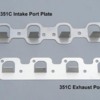quote:
I would NOT use intake port stuffers with a manifold that was designed for a full size port. You are second guessing the designer at that point.
In general many of the aftermarket intake designers are "trying stuff" like everone else.. I think "trying stuff" is how "car guys" and "hot rodders" learn stuff and is the basis for much great knowledge people have. Nothing like turning a wrench vs cyber theories.
I know some GM intake manifolds used on the vette that had intake ports that opened and closed based on throttle position. This is the best of both worlds! That was what I was talking about a while back what I thought of making my own aluminum manifold. Ports that open and close would be keen!
Gary


